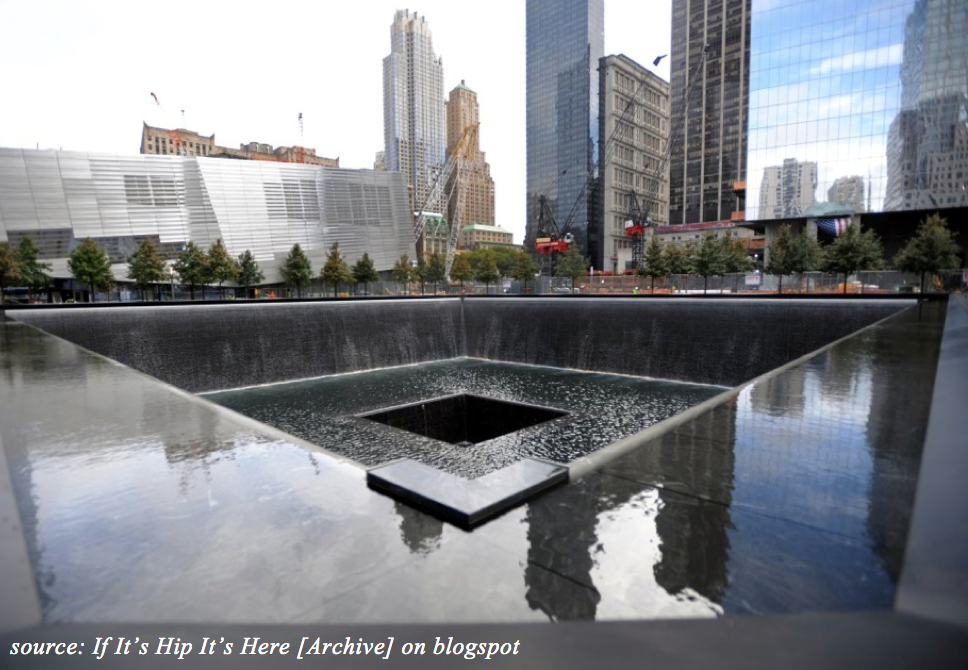9/11 Museum: tragedy and gift shops

One of two water sculptures commemorating the location of the World Trade Center.
(Photo courtesy of Blogspot.com)
By Stephany Harrington, Staff Writer
Thirteen years ago the entire country was in complete disarray and despair. The terrorist attacks on September 11, 2001 became the most devastating tragedy in recent American memory. The aftermath of these events have been on my mind quite a bit lately, because just this past weekend I visited the 9/11 Memorial in New York City. I went with my German class because we are studying political memory in a German context. However, for us to better understand memory, it was important for us to approach the topic from a more relatable level. For those reasons, the 9/11 Memorial was an appropriate place to try and understand our personal and collective American memory.
Going into this trip I realized that it would probably not be an easy experience, but I was not prepared for what I would actually face there. The memorial outside in the World Trade Plaza was beautiful with two large square fountains cascading water, matching the exact footprints of where the original towers once stood. I found standing around those pools very peaceful, but that all changed when I entered the museum. At seven to eight stories underground, the museum holds many artifacts from the day the attacks occurred and the subsequent excavation that took many years thereafter. The foundation of one of the original towers remained and served as a wall of the museum, and a partially destroyed but salvaged fire truck was displayed as one of the big items that was recovered from the rubble and debris.
The things I saw in this part of the museum were interesting and sometimes difficult, but it did not compare to the enclosed exhibit. There, a timeline of events led me through the museum. It detailed the exact moments of attack and the responses. It not only focused on the situations in New York, but also in Washington, D.C. and Pennsylvania. It was clear that this part of the museum was intended to be a completely emotional experience. The continuous replaying of videos of the plane flying into the second tower, as well as footage of the trapped people jumping to their deaths rather than stay in the building completely shed any emotional armor that I thought I had.
Although I was only eight years old at the time of the 9/11 attacks and I could not fully understand the complexity and severity of the situation, I still knew it was a trauma. Through the responses of the adults around me and the videos on the television, I knew something terrible had happened. I grew up living in a world of aftermath and coping, but this experience at the museum traumatized me. As an adult I now grasp the things I previously could not quite wrap my head around.
By the time I emerged from the exhibit and met up with the group, I was totally drained. I felt tired and unfriendly because the overwhelming bombardment of tragedy took its toll on me. For a while, I just wanted some peace.
After the powerful exhibit that the museum provided, I was stunned that there was even a museum store. I thought I had read months ago when the museum opened in May that the store was controversial. And from my personal experience I would say that is entirely accurate. The museum was a bit dark, but the store was brightly illuminated with white walls and adorned with consumer goods. As in most museums, they had books for sale, which I did not take issue with. But as I continued to take it all in, I was shocked: mugs, t-shirts, bookmarks, Christmas ornaments, and twin towers earrings were for sale. They even had stuffed animal dogs for children.
All I could think about was how disgusting it was that they were capitalizing on someone else’s tragedy. They are selling cheap shirts and mugs on the site of a mass grave just to turn a profit. I hated that the consumer ideals of American society transferred over to a place that deserves peace and respect. It was hard to watch people enthusiastically pick out their t-shirts and examine the tacky other items they wanted to purchase. I walked through the store dismayed and appalled, because we all saw terrible things in the exhibit and these people wanted to have their souvenir.
Although the visit was certainly an experience for me, the final stop at the museum store tarnished that experience. I know that the museum needs funds so it can remain open, but donations and selling only books would be more appropriate. Understanding the brutal nature of our consumer culture most definitely was not the American experience that I came to see that day.
